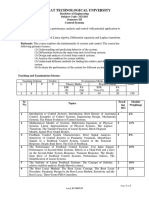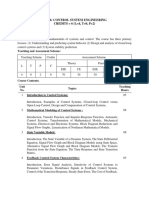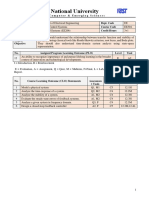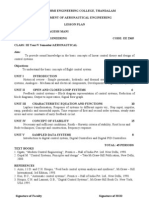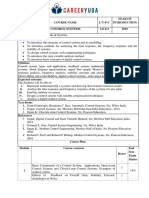Subject: Control Systems B.
Tech CSE Course Credit: 3
(Code: EET254) 2nd Year (4thSemester ) L T P
3 0 0
Mid-Term Continuous Assessment End-Term
Evaluation Policy
(26 Marks) (24 Marks) (50 Marks)
Course Outcomes (COs): After completing the course, the students will be able to
CO1: Design control systems for real-world problems by applying the concept of open-loop
and closed-loop. Design PID controllers, lead-lag compensators and perform modeling of
dynamic systems in state space.
CO2: Analyze the mathematical modeling of control systems using transfer function, block
diagram, and signal flow graph.
CO3: Determine the time response of first and second-order systems and assess these
systems for various standard test inputs.
CO4: Investigate, evaluate, and analyze the stability of control systems.
Module I: Introduction to continuous control systems:
Definition of a control system, open-loop, closed-loop (automatic and manual) control.
Module II: Mathematical modeling:
Transfer functions, block diagrams, signal flow graphs
Module III: First and second order system:
Examples of first and second-order systems, and responses of these systems to step, ramp, parabolic
and sinusoidal inputs. Transient, steady state, and error analysis
Module IV: Stability studies:
Definition of stability, stability and pole locations, stability and Routh-table, stability, and frequency
response bode-plot, polar-plot, root-locus.
Module V: Study of PID controllers, lead-lag Compensators
Proportional, Integral, Derivative (P.I.D) control. Compensator design Lead – lag compensators,
Modeling of dynamic systems in state space (Introduction).
Text Books:
1. Control Systems Engineering, Norman S. Nise, Wiley.
2. Control Systems (Principles and Design), M. Gopal, Tata McGraw-Hill.
Reference Books:
1. Control systems, Anand Kumar, PHI Learning Private Limited.
2. Feedback control of dynamic systems, Franklin and Powel, Prentice Hall.
3. Design of feedback control systems, Stefani, Oxford University Press.
